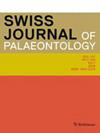Otoliths of the Gobiidae from the Neogene of tropical America
IF 3
2区 地球科学
Q1 PALEONTOLOGY
引用次数: 0
Abstract
Otoliths are common and diverse in the Neogene of tropical America. Following previous studies of Neogene tropical American otoliths of the lanternfishes (Myctophidae), marine catfishes (Ariidae), croakers (Sciaenidae), and cusk-eels (Ophidiiformes), we describe here the otoliths of the gobies (Gobiidae). The Gobiidae represent the richest marine fish family, with more than 2000 species worldwide and about 250 in America. In the fossil record too they are the species richest family in the Neogene of tropical America. We have investigated otoliths sampled from Ecuador, Pacific and Atlantic Panama, Atlantic Costa Rica, Dominican Republic, Venezuela, and Trinidad, ranging in age from late Early Miocene (late Burdigalian) to late Early Pleistocene (Calabrian). Most of the studied material originates from the collection expeditions of the Panama Paleontology Project (PPP). Our study represents the first comprehensive record of fossil gobies from America, and we recognize 107 species, of which 51 are new to science, 35 are in open nomenclature, and 19 represent species that also live in the region today. Previously, only two fossil otolith-based goby species have been described from the Neogene of tropical America. The dominant gobies in the fossil record of the region are from the Gobiosomatini, particularly of genera living over soft bottoms or in deeper water such as Bollmannia, Microgobius, Antilligobius, and Palatogobius. Another purpose of our study is to provide a first comprehensive account of otoliths of the extant Gobiidae of America, which we consider necessary for an adequate identification and interpretation of the Neogene otoliths. We studied otoliths of 130 extant American gobiid species and figured 106 of them for comparison. We also present a morphological analysis and characterization of the extant otoliths as a basis for the identification of fossil otoliths. Problems that commonly arise with the identification of fossil otoliths and specifically of fossil goby otoliths are addressed and discussed. A comparison of the history of the Gobiidae in tropical America reveals a high percentage of shared species between the Pacific and the Atlantic basins during the Late Miocene (Tortonian and Messinian) from at least 11 to 6 Ma. A recording gap on the Pacific side across the Pliocene allows a comparison again only in the late Early Pleistocene (Calabrian, 1.8 to 0.78 Ma), which shows a complete lack of shared species. These observations support the effective closure of the former Central American Seaway and emersion of the Isthmus of Panama in the intervening time. Groups that today only exist in the East Pacific were also identified in the Miocene and Pliocene of the West Atlantic, and there is also at least one instance of a genus now restricted to the West Atlantic having occurred in the East Pacific as late as the Pleistocene. The evolution of gobies in tropical America and the implications thereof are extensively discussed. Furthermore, observations of fossil gobies in the region are discussed in respect to paleoenvironmental indications and paleobiogeographic aspects.美洲热带新近纪戈壁鱼科的耳石
耳石在美洲热带新近纪十分常见,而且种类繁多。继之前对灯笼鱼科(Myctophidae)、海鲶科(Ariidae)、黄花鱼科(Sciaenidae)和黄鳝科(Ophidiiformes)的新元古代热带美洲耳石的研究之后,我们在此介绍虾虎鱼科(Gobiidae)的耳石。虾虎鱼科是最丰富的海洋鱼类家族,在全世界有 2000 多个物种,在美洲约有 250 个物种。在化石记录中,它们也是美洲热带新近纪物种最丰富的科。我们研究了从厄瓜多尔、太平洋和大西洋巴拿马、大西洋哥斯达黎加、多米尼加共和国、委内瑞拉和特立尼达取样的耳石,其年代从早中新世晚期(布迪加里安晚期)到早更新世晚期(卡拉布里亚)不等。研究的大部分材料来自巴拿马古生物学项目(PPP)的采集考察。我们的研究首次全面记录了美洲的虾虎鱼化石,我们确认了 107 个物种,其中 51 个是科学界的新物种,35 个属于开放命名,19 个代表了今天也生活在该地区的物种。在此之前,美洲热带新近纪只描述了两个基于耳石的虾虎鱼化石物种。该地区化石记录中最主要的虾虎鱼属于虾虎鱼科,尤其是生活在软底或深水中的虾虎鱼属,如 Bollmannia、Microgobius、Antilligobius 和 Palatogobius。我们研究的另一个目的是首次全面介绍美洲现生戈壁鱼科的耳石,我们认为这对于充分鉴定和解释新近纪耳石是必要的。我们研究了 130 种现存美洲戈壁鱼类的耳石,并对其中 106 种进行了图解,以便进行比较。我们还对现生耳石进行了形态分析和特征描述,以此作为鉴定耳石化石的基础。我们还讨论了在鉴定耳石化石,特别是虾虎鱼耳石化石时经常出现的问题。通过比较美洲热带戈壁鱼科的历史,发现在晚中新世(托尔托尼世和梅西尼亚世)期间,太平洋盆地和大西洋盆地至少在 11 至 6 Ma 之间有很高比例的共享物种。由于太平洋一侧在上新世的记录空白,因此只有在早更新世晚期(卡拉布里亚,1.8-0.78 Ma)才能再次进行比较,结果显示完全没有共享物种。这些观察结果支持了前中美洲海道的有效关闭和巴拿马地峡在这一时期的形成。在西大西洋的中新世和上新世也发现了今天只存在于东太平洋的鱼群,而且至少有一个现在仅限于西大西洋的鱼属早在更新世就出现在东太平洋。文章广泛讨论了虾虎鱼在美洲热带地区的演化及其影响。此外,还从古环境迹象和古生物地理学方面讨论了对该地区虾虎鱼化石的观察。
本文章由计算机程序翻译,如有差异,请以英文原文为准。
求助全文
约1分钟内获得全文
求助全文
来源期刊

Swiss Journal of Palaeontology
Earth and Planetary Sciences-Paleontology
CiteScore
4.30
自引率
16.70%
发文量
17
审稿时长
4 weeks
期刊介绍:
The Swiss Journal of Palaeontology publishes original research and review articles of interest to the international community in the fields of palaeontology, taxonomy and systematics, while recognising at the same time the importance of documenting high-quality palaeontological data in a regional context. Palaeobiology in combination with alpha taxonomy is a core topic of the journal.
Submitted papers should have an appeal as wide as possible, directed towards an international readership. Contributions should not have been simultaneously submitted elsewhere, and the overlap of content between related articles should be minimal. Duplications of text and the use of previously published illustrations without adequate citation are unacceptable. If a manuscript has two or more authors, both or all have to sign to confirm they all were involved in the work and have agreed to its submission. The preferred manuscript language is UK English, but consistently used US English is also acceptable. We encourage the publication of proceedings of international meetings as well as special thematic issues. Short contributions and book reviews are also accepted.
An international editorial team as well as guest editors guarantee that the thematic issues as well as all articles in regular issues are peer-reviewed and meet the highest standards.
 求助内容:
求助内容: 应助结果提醒方式:
应助结果提醒方式:


